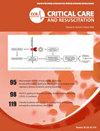Mean arterial pressure in critically ill adults receiving vasopressors: A multicentre, observational study
IF 1.4
4区 医学
Q3 CRITICAL CARE MEDICINE
引用次数: 0
Abstract
Objective
Mean arterial pressure (MAP) management is a key aspect of treatment in critically ill patients receiving vasopressor therapy. Guidelines in different clinical subgroups have proposed various target MAP values. This study aimed to describe delivered MAP values and corresponding vasopressor doses in such patients.
Design
Multicenter, retrospective cohort study of adult intensive care unit (ICU) admissions.
Setting
12 ICUs in Queensland, Australia, from January 1, 2015, to December 31, 2021.
Participants
Patients receiving vasopressors for at least six continuous hours in the ICU. We studied the delivered MAP values using hourly data based on averaging all validated values obtained from the ICU monitors and average hourly doses of vasopressors.
Main Outcome Measure
The primary outcome was the mean MAP during the entire cohort's first 72 hours of ICU admission, whilst vasopressors were administered.
Results
In 26,519 patients who received vasopressors for at least six continuous hours, the median age was 62 years, and 9,373 (35%) were admitted after elective surgery. The median time from ICU admission to vasopressor commencement was 2 hours, and the median duration of vasopressor therapy was 27 hours. At 72 hours, 6,627 (25.0%) patients remained on vasopressors. The mean hourly MAP was 72 mmHg in the first six hours, then steadily increased to ≈75 mmHg at 72 hours. In the first 72 hours, 11,032 (41.6%) patients had a mean MAP of 70-74 mmHg, and 5,914 (22.3%) had a mean MAP of 75-79 mmHg. For every clinical subgroup, a MAP of 70-74 mmHg was the most common mean MAP, and the proportion of patients with a mean MAP of 60-65mmHg was less than 5%.
Conclusions
In a large, multicenter study of heterogeneous critically ill patients on vasopressors, the mean hourly MAP was > 70 mmHg. This mean hourly MAP was observed consistently over diverse clinical subgroups and is higher than recommended by guidelines.
接受血管加压药物治疗的危重成人平均动脉压:一项多中心观察性研究
目的动脉平均压(MAP)管理是危重患者接受血管加压治疗的关键。不同临床亚组的指南提出了不同的MAP目标值。本研究旨在描述这些患者的MAP传递值和相应的血管加压剂剂量。设计:成人重症监护病房(ICU)入院的多中心、回顾性队列研究。2015年1月1日至2021年12月31日,澳大利亚昆士兰州的12个icu。受试者:在ICU接受血管加压药物治疗至少连续6小时的患者。我们使用每小时的数据来研究每小时的MAP值,该数据基于从ICU监护仪获得的所有验证值的平均值和每小时的血管加压剂剂量。主要结局指标主要结局指标是整个队列在接受血管加压药物治疗期间入住ICU前72小时的平均MAP。结果26519例连续使用血管加压药物至少6小时的患者中位年龄为62岁,其中9373例(35%)择期手术后入院。从进入ICU到开始使用血管加压素的中位时间为2小时,血管加压素治疗的中位持续时间为27小时。72小时时,6627例(25.0%)患者继续使用血管加压药物。平均每小时MAP在前6小时为72 mmHg,然后在72小时稳步增加到约75 mmHg。在前72小时,11032例(41.6%)患者的平均MAP为70-74 mmHg, 5914例(22.3%)患者的平均MAP为75-79 mmHg。对于每个临床亚组,MAP为70-74 mmHg是最常见的平均MAP,平均MAP为60-65mmHg的患者比例小于5%。结论在一项大型多中心研究中,异质性的危重患者接受血管加压药物治疗,平均每小时MAP为>;70毫米汞柱。在不同临床亚组中观察到的平均每小时MAP一致,高于指南的推荐值。
本文章由计算机程序翻译,如有差异,请以英文原文为准。
求助全文
约1分钟内获得全文
求助全文
来源期刊

Critical Care and Resuscitation
CRITICAL CARE MEDICINE-
CiteScore
7.70
自引率
3.40%
发文量
44
审稿时长
>12 weeks
期刊介绍:
ritical Care and Resuscitation (CC&R) is the official scientific journal of the College of Intensive Care Medicine (CICM). The Journal is a quarterly publication (ISSN 1441-2772) with original articles of scientific and clinical interest in the specialities of Critical Care, Intensive Care, Anaesthesia, Emergency Medicine and related disciplines.
The Journal is received by all Fellows and trainees, along with an increasing number of subscribers from around the world.
The CC&R Journal currently has an impact factor of 3.3, placing it in 8th position in world critical care journals and in first position in the world outside the USA and Europe.
 求助内容:
求助内容: 应助结果提醒方式:
应助结果提醒方式:


